Advertisements
Advertisements
प्रश्न
Find the time period of small oscillations of the following systems. (a) A metre stick suspended through the 20 cm mark. (b) A ring of mass m and radius r suspended through a point on its periphery. (c) A uniform square plate of edge a suspended through a corner. (d) A uniform disc of mass m and radius r suspended through a point r/2 away from the centre.
उत्तर
(a) Moment Of inertia \[\left( I \right)\] about the point X is given by ,
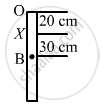
I = IC.G + mh2
\[= \frac{m l^2}{12} + m h^2 \]
\[ = \frac{m l^2}{12} + m \left( 0 . 3 \right)^2 \]
\[ = m\left( \frac{1}{12} + 0 . 09 \right)\]
\[ = m\left( \frac{1 + 1 . 08}{12} \right)\]
\[ = m\left( \frac{2 . 08}{12} \right)\]
The time Period \[\left( T \right)\] is given by,
\[T = 2\pi\sqrt{\frac{I}{mgl}}\] \[\text { where } I = \text{ the moment of inertia, and } \] \[ l= \text{ distance between the centre of gravity and the point of suspension . }\] \[\text {On substituting the respective values in the above formula, we get: }\] \[T = 2\pi\sqrt{\frac{2 . 08 m}{m \times 12 \times 9 . 8 \times 0 . 3}}\]
\[ = 1 . 52 s\]
(b) Moment Of inertia \[\left( I \right)\] about A is given as,
I = IC.G. + mr2 = mr2 + mr2 = 2mr2

The time period (T) will be,
\[T = 2\pi\sqrt{\frac{I}{mgl}}\]
\[\text { On substituting the respective values in the above equation, we have: }\]
\[T = 2\pi\sqrt{\frac{2m r^2}{mgr}}\]
\[ = 2\pi\sqrt{\frac{2r}{g}}\]
(c) Let I be the moment of inertia of a uniform square plate suspended through a corner.
\[I = m\left( \frac{a^2 + a^2}{3} \right) = \frac{2m}{3} a^2\]
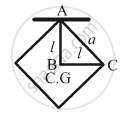
In the
\[\bigtriangleup\] ABC , l2 + l2 = a2
\[\therefore l = \frac{a}{\sqrt{2}}\]
\[ \Rightarrow T = 2\pi\sqrt{\frac{I}{mgl}}\]
\[ = 2\pi\sqrt{\frac{2m a^2}{3mgl}}\]
\[ = 2\pi\sqrt{\frac{2 a^2}{3ga\sqrt{2}}}\]
\[ = 2\pi\sqrt{\frac{\sqrt{8}a}{3g}}\]
(d)
\[\text { We know }\]
\[ h = \frac{r}{2}\]
\[\text { Distance between the C . G . and suspension point }, l = \frac{r}{2}\]
Moment of inertia about A will be:
l = IC.G. + mh2
\[= \frac{m r^2}{2} + m \left( \frac{r}{2} \right)^2 \]
\[ = m r^2 \left( \frac{1}{2} + \frac{1}{4} \right) = \frac{3}{4}m r^2\]
Time period (T) will be,
\[T = 2\pi\sqrt{\frac{I}{mgl}}\]
\[ = 2\pi\sqrt{\frac{3m r^2}{4mgl}} = 2\pi\sqrt{\frac{3r}{2g}}\]
APPEARS IN
संबंधित प्रश्न
A copper metal cube has each side of length 1 m. The bottom edge of the cube is fixed and tangential force 4.2x108 N is applied to a top surface. Calculate the lateral displacement of the top surface if modulus of rigidity of copper is 14x1010 N/m2.
Answer in brief:
Derive an expression for the period of motion of a simple pendulum. On which factors does it depend?
The length of the second’s pendulum in a clock is increased to 4 times its initial length. Calculate the number of oscillations completed by the new pendulum in one minute.
A particle executes simple harmonic motion with a frequency v. The frequency with which the kinetic energy oscillates is
A particle executes simple harmonic motion under the restoring force provided by a spring. The time period is T. If the spring is divided in two equal parts and one part is used to continue the simple harmonic motion, the time period will
Two bodies A and B of equal mass are suspended from two separate massless springs of spring constant k1 and k2 respectively. If the bodies oscillate vertically such that their maximum velocities are equal, the ratio of the amplitude of A to that of B is
The position, velocity and acceleration of a particle executing simple harmonic motion are found to have magnitude 2 cm, 1 m s−1 and 10 m s−2 at a certain instant. Find the amplitude and the time period of the motion.
A spring stores 5 J of energy when stretched by 25 cm. It is kept vertical with the lower end fixed. A block fastened to its other end is made to undergo small oscillations. If the block makes 5 oscillations each second what is the mass of the block?
The left block in figure moves at a speed v towards the right block placed in equilibrium. All collisions to take place are elastic and the surfaces are frictionless. Show that the motions of the two blocks are periodic. Find the time period of these periodic motions. Neglect the widths of the blocks.
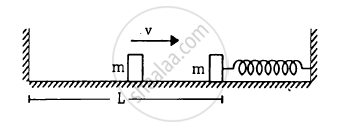
Find the time period of the motion of the particle shown in figure . Neglect the small effect of the bend near the bottom.
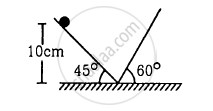
The maximum speed of a particle executing S.H.M. is 10 m/s and maximum acceleration is 31.4 m/s2. Its periodic time is ______
Which of the following example represent periodic motion?
A swimmer completing one (return) trip from one bank of a river to the other and back.
Which of the following example represent periodic motion?
A freely suspended bar magnet displaced from its N-S direction and released.
Which of the following example represent (nearly) simple harmonic motion and which represent periodic but not simple harmonic motion?
A motion of an oscillating mercury column in a U-tube.
The equation of motion of a particle is x = a cos (αt)2. The motion is ______.
The displacement time graph of a particle executing S.H.M. is shown in figure. Which of the following statement is/are true?
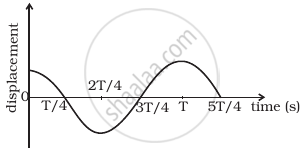
- The force is zero at `t = (T)/4`.
- The acceleration is maximum at `t = (4T)/4`.
- The velocity is maximum at `t = T/4`.
- The P.E. is equal to K.E. of oscillation at `t = T/2`.
A person normally weighing 50 kg stands on a massless platform which oscillates up and down harmonically at a frequency of 2.0 s–1 and an amplitude 5.0 cm. A weighing machine on the platform gives the persons weight against time.
- Will there be any change in weight of the body, during the oscillation?
- If answer to part (a) is yes, what will be the maximum and minimum reading in the machine and at which position?
The time period of a simple pendulum is T inside a lift when the lift is stationary. If the lift moves upwards with an acceleration `g/2`, the time period of the pendulum will be ______.
